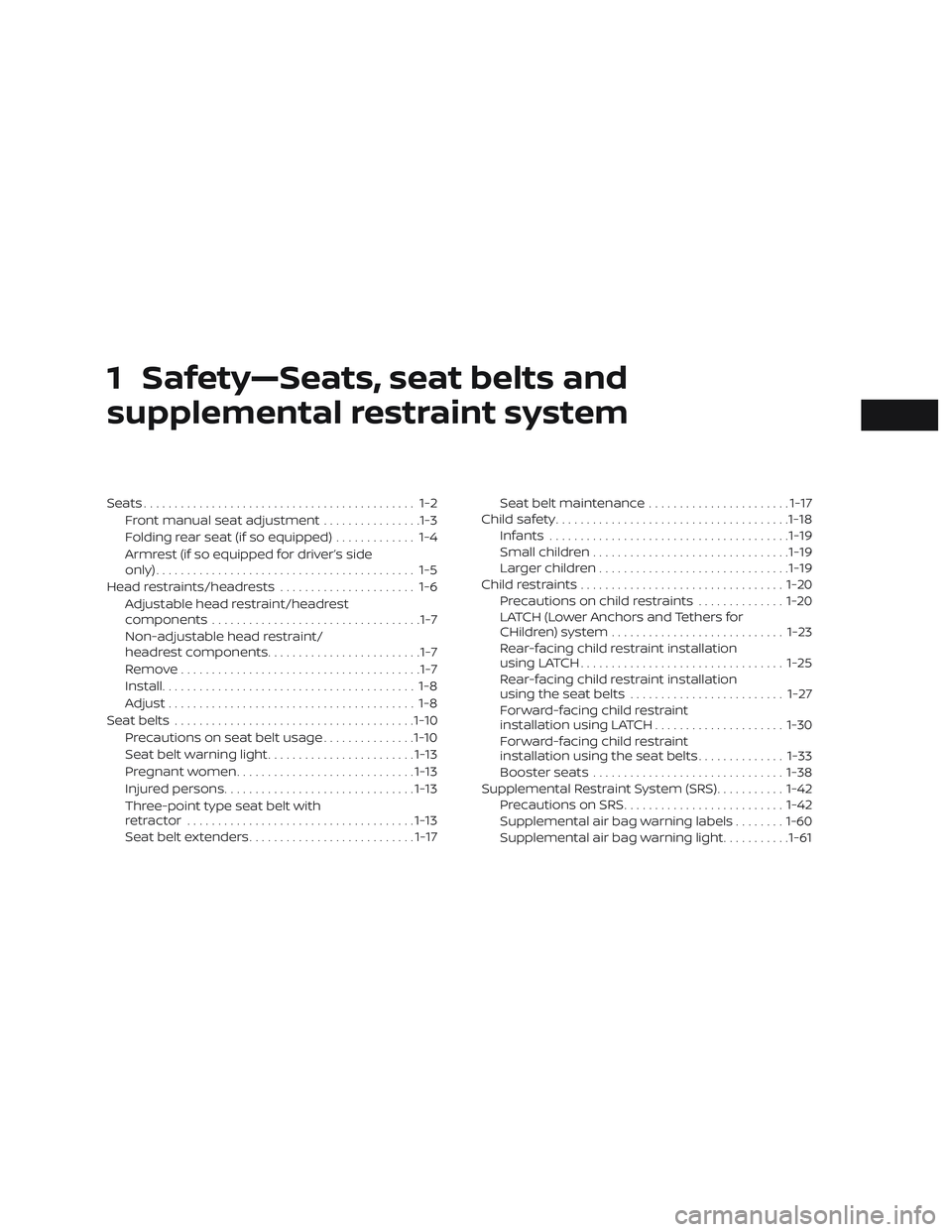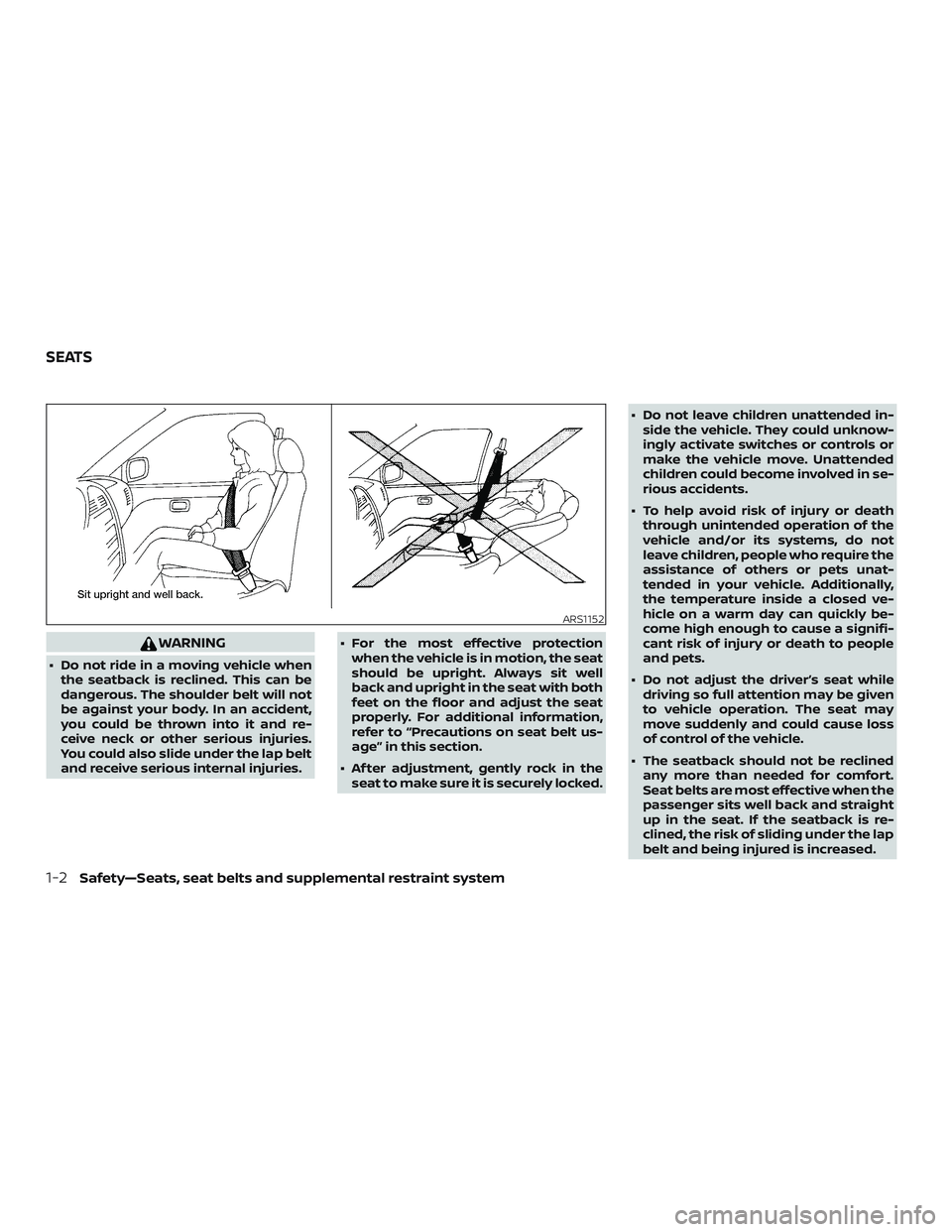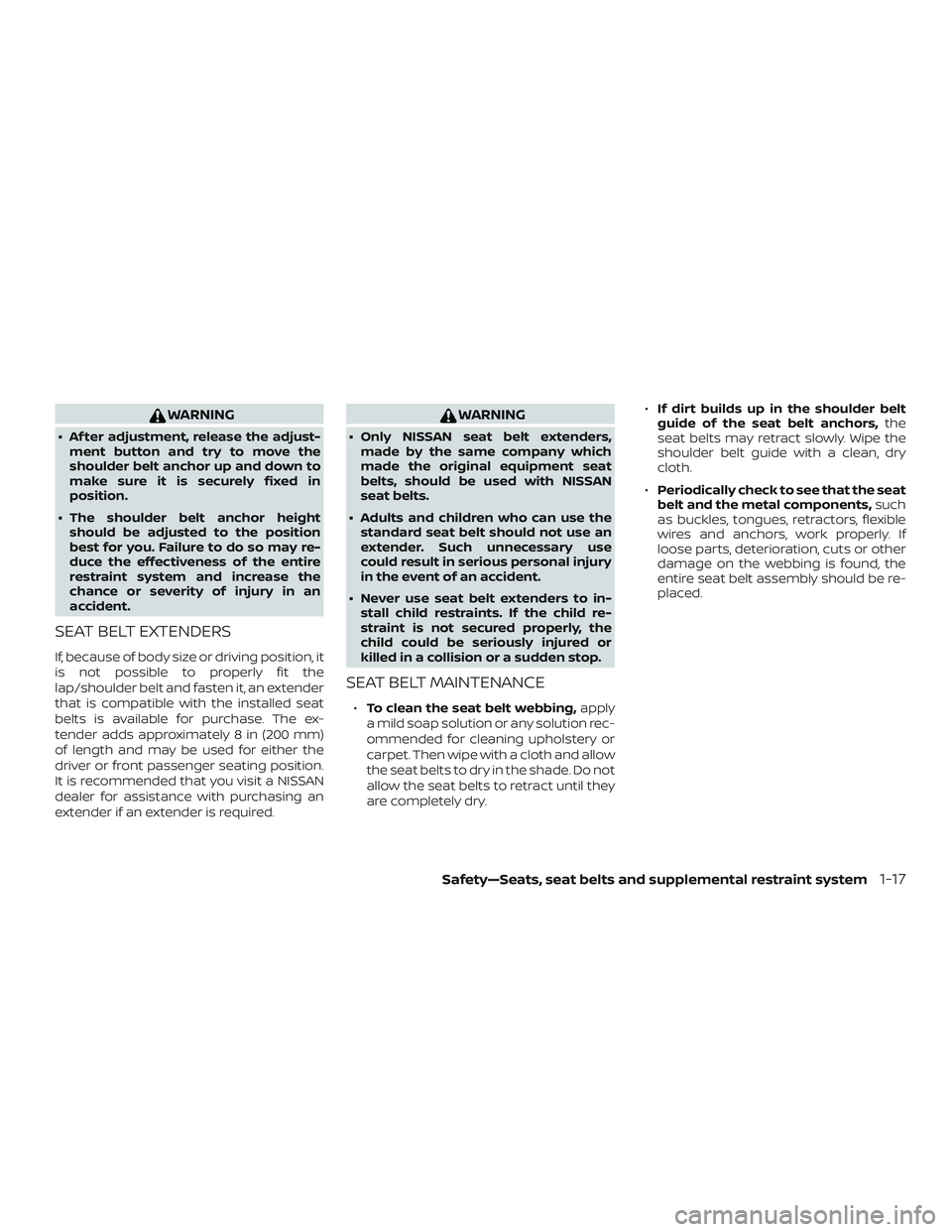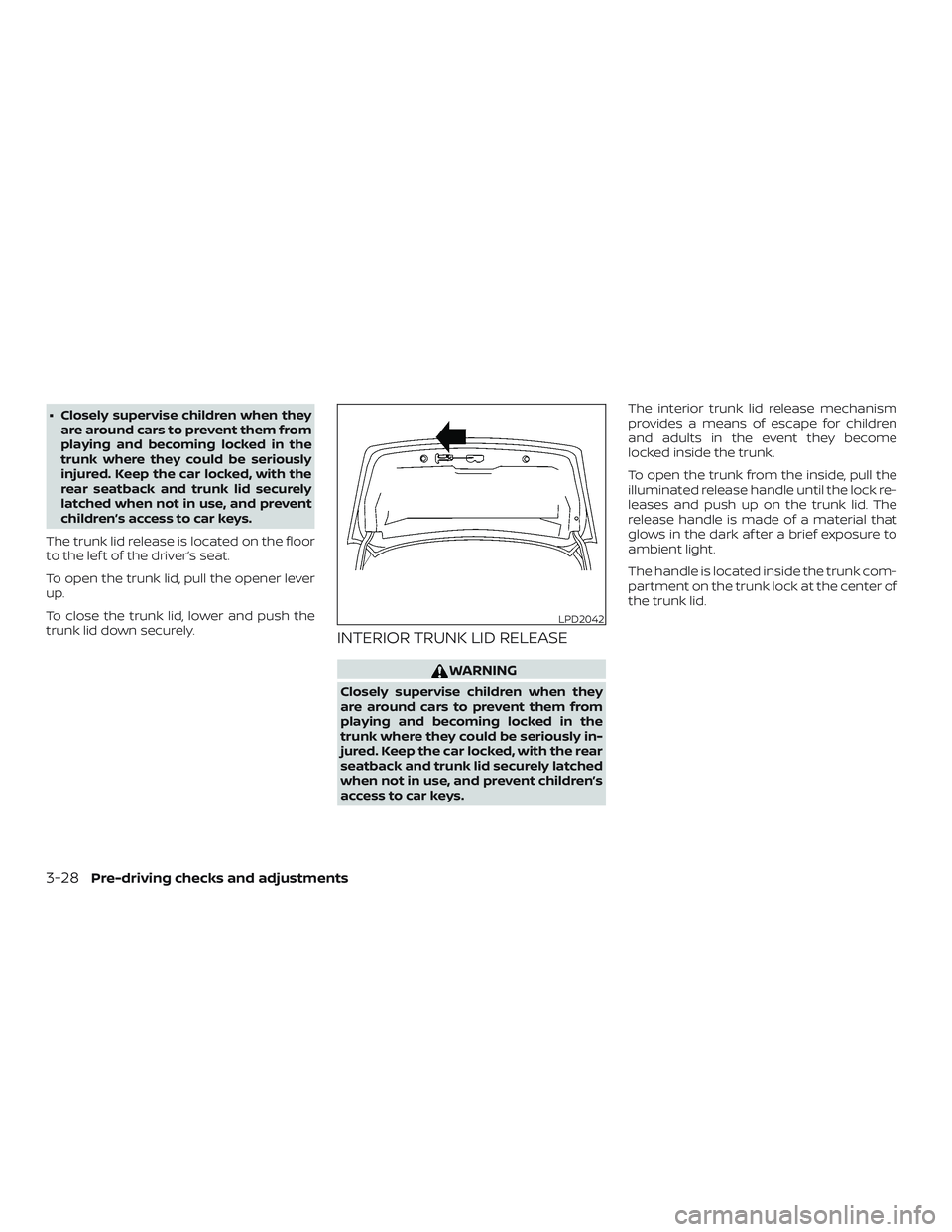2019 NISSAN VERSA SEDAN driver seat adjustment
[x] Cancel search: driver seat adjustmentPage 19 of 372

1 Safety—Seats, seat belts and
supplemental restraint system
Seats............................................ 1-2Front manual seat adjustment ................1-3
Folding rear seat (if so equipped) ............. 1-4
Armrest (if so equipped for driver’s side
only).......................................... 1-5
Head restraints/headrests ...................... 1-6
Adjustable head restraint/headrest
components ..................................1-7
Non-adjustable head restraint/
headrest components .........................1-7
Remove.......................................1-7
Install ......................................... 1-8
Adjust ........................................ 1-8
Seatbelts ....................................... 1-10
Precautions on seat belt usage ...............1-10
Seat belt warning light ........................ 1-13
Pregnant women ............................. 1-13
Injured persons ............................... 1-13
Three-point type seat belt with
retractor ..................................... 1-13
Seat belt extenders ........................... 1-17Seat belt maintenance
.......................1-17
Child safety ...................................... 1-18
Infants ....................................... 1-19
Small children ................................ 1-19
Larger children ............................... 1-19
Child restraints ................................. 1-20
Precautions on child restraints ..............1-20
LATCH (Lower Anchors and Tethers for
CHildren) system ............................ 1-23
Rear-facing child restraint installation
using LATCH ................................. 1-25
Rear-facing child restraint installation
using the seat belts ......................... 1-27
Forward-facing child restraint
installation using LATCH .....................1-30
Forward-facing child restraint
installation using the seat belts ..............1-33
Booster seats ............................... 1-38
Supplemental Restraint System (SRS) ...........1-42
Precautions on SRS .......................... 1-42
Supplemental air bag warning labels ........1-60
Supplemental air bag warning light ...........1-61
Page 20 of 372

WARNING
∙ Do not ride in a moving vehicle whenthe seatback is reclined. This can be
dangerous. The shoulder belt will not
be against your body. In an accident,
you could be thrown into it and re-
ceive neck or other serious injuries.
You could also slide under the lap belt
and receive serious internal injuries. ∙ For the most effective protection
when the vehicle is in motion, the seat
should be upright. Always sit well
back and upright in the seat with both
feet on the floor and adjust the seat
properly. For additional information,
refer to “Precautions on seat belt us-
age” in this section.
∙ Af ter adjustment, gently rock in the seat to make sure it is securely locked. ∙ Do not leave children unattended in-
side the vehicle. They could unknow-
ingly activate switches or controls or
make the vehicle move. Unattended
children could become involved in se-
rious accidents.
∙ To help avoid risk of injury or death through unintended operation of the
vehicle and/or its systems, do not
leave children, people who require the
assistance of others or pets unat-
tended in your vehicle. Additionally,
the temperature inside a closed ve-
hicle on a warm day can quickly be-
come high enough to cause a signifi-
cant risk of injury or death to people
and pets.
∙ Do not adjust the driver’s seat while driving so full attention may be given
to vehicle operation. The seat may
move suddenly and could cause loss
of control of the vehicle.
∙ The seatback should not be reclined any more than needed for comfort.
Seat belts are most effective when the
passenger sits well back and straight
up in the seat. If the seatback is re-
clined, the risk of sliding under the lap
belt and being injured is increased.
ARS1152
SEATS
1-2Safety—Seats, seat belts and supplemental restraint system
Page 35 of 372

WARNING
∙ Af ter adjustment, release the adjust-ment button and try to move the
shoulder belt anchor up and down to
make sure it is securely fixed in
position.
∙ The shoulder belt anchor height should be adjusted to the position
best for you. Failure to do so may re-
duce the effectiveness of the entire
restraint system and increase the
chance or severity of injury in an
accident.
SEAT BELT EXTENDERS
If, because of body size or driving position, it
is not possible to properly fit the
lap/shoulder belt and fasten it, an extender
that is compatible with the installed seat
belts is available for purchase. The ex-
tender adds approximately 8 in (200 mm)
of length and may be used for either the
driver or front passenger seating position.
It is recommended that you visit a NISSAN
dealer for assistance with purchasing an
extender if an extender is required.
WARNING
∙ Only NISSAN seat belt extenders,made by the same company which
made the original equipment seat
belts, should be used with NISSAN
seat belts.
∙ Adults and children who can use the standard seat belt should not use an
extender. Such unnecessary use
could result in serious personal injury
in the event of an accident.
∙ Never use seat belt extenders to in- stall child restraints. If the child re-
straint is not secured properly, the
child could be seriously injured or
killed in a collision or a sudden stop.
SEAT BELT MAINTENANCE
∙ To clean the seat belt webbing, apply
a mild soap solution or any solution rec-
ommended for cleaning upholstery or
carpet. Then wipe with a cloth and allow
the seat belts to dry in the shade. Do not
allow the seat belts to retract until they
are completely dry. ∙
If dirt builds up in the shoulder belt
guide of the seat belt anchors, the
seat belts may retract slowly. Wipe the
shoulder belt guide with a clean, dry
cloth.
∙ Periodically check to see that the seat
belt and the metal components, such
as buckles, tongues, retractors, flexible
wires and anchors, work properly. If
loose parts, deterioration, cuts or other
damage on the webbing is found, the
entire seat belt assembly should be re-
placed.
Safety—Seats, seat belts and supplemental restraint system1-17
Page 67 of 372

NISSAN Advanced Air Bag System
(front seats)
1. Seat belt with pretensioner(s) (frontseats)
2. Shoulder belt height adjustment (front seats) (if so equipped)
3. Front door satellite sensor (driver’s side shown; front passenger side similar)
4. Crash zone sensor
5. Supplemental front-impact air bag modules
6. Air bag Control Unit (ACU)
7. Occupant classification sensor (weight sensor – located in front passenger
cushion frame)
8. Front seat-mounted side-impact supplemental air bag modules
9. Roof-mounted curtain side-impact and rollover supplemental air bag
10. Side satellite sensor
LRS3097
Safety—Seats, seat belts and supplemental restraint system1-49
Page 98 of 372

NISSAN Intelligent Key®warning light (if so
equipped)
The Intelligent Key warning light illumi-
nates green when the ignition switch can
be turned. The Intelligent Key warning light
illuminates red when the ignition switch
cannot be turned.
The Intelligent Key warning light blinks red if
the Intelligent Key is taken outside of the
vehicle while the ignition switch is placed in
the ACC or ON position.
∙ If the Intelligent Key warning light blinks, make sure of the location of the Intelli-
gent Key as soon as possible. The Intel-
ligent Key should be carried by the
driver while operating the vehicle.
∙ The Intelligent Key warning light turns off about 10 seconds af ter the Intelli-
gent Key is brought inside the vehicle.
The Intelligent Key warning light blinks
green indicating that the Intelligent Key
battery is almost discharged.
For additional information, refer to “NISSAN
Intelligent Key®” in the “Pre-driving checks
and adjustments” section of this manual.
Power steering warning light
WARNING
∙ If the engine is not running or is turned off while driving, the power as-
sist for the steering will not work.
Steering will be harder to operate.
∙ When the power steering warning light illuminates with the engine run-
ning, there will be no power assist for
the steering. You will still have control
of the vehicle, but the steering will be
harder to operate. Have the power
steering system checked. It is recom-
mended that you visit a NISSAN dealer
for this service.
When the ignition switch is placed in the ON
position, the power steering warning light
illuminates. Af ter starting the engine, the
power steering warning light turns off. This
indicates the power steering is operational.
If the power steering warning light illumi-
nates while the engine is running, it may
indicate the power steering is not function-
ing properly and may need servicing. Have
the power steering checked. It is recom-
mended that you visit a NISSAN dealer for
this service. When the power steering warning light illu-
minates with the engine running, there will
be no power assist for the steering, but you
will still have control of the vehicle. At this
time, greater steering effort is required to
operate the steering wheel, especially in
sharp turns and at low speeds.
For additional information, refer to “Power
steering” in the “Starting and driving” sec-
tion of this manual.
Seat belt warning light and
chime
The light and chime remind you to fasten
your seat belts. The light illuminates when-
ever the ignition switch is placed in the ON
or START position and remains illuminated
until the driver’s seat belt is fastened. At the
same time, the chime sounds for about
6 seconds unless the driver’s seat belt is
securely fastened.
The seat belt warning light may also illumi-
nate if the front passenger’s seat belt is not
fastened when the front passenger’s seat
is occupied . For 7 seconds af ter the igni-
tion switch is placed in the ON position, the
system does not activate the warning light
for the front passenger.
2-18Instruments and controls
Page 146 of 372

∙ Closely supervise children when theyare around cars to prevent them from
playing and becoming locked in the
trunk where they could be seriously
injured. Keep the car locked, with the
rear seatback and trunk lid securely
latched when not in use, and prevent
children’s access to car keys.
The trunk lid release is located on the floor
to the lef t of the driver’s seat.
To open the trunk lid, pull the opener lever
up.
To close the trunk lid, lower and push the
trunk lid down securely.
INTERIOR TRUNK LID RELEASE
WARNING
Closely supervise children when they
are around cars to prevent them from
playing and becoming locked in the
trunk where they could be seriously in-
jured. Keep the car locked, with the rear
seatback and trunk lid securely latched
when not in use, and prevent children’s
access to car keys. The interior trunk lid release mechanism
provides a means of escape for children
and adults in the event they become
locked inside the trunk.
To open the trunk from the inside, pull the
illuminated release handle until the lock re-
leases and push up on the trunk lid. The
release handle is made of a material that
glows in the dark af ter a brief exposure to
ambient light.
The handle is located inside the trunk com-
partment on the trunk lock at the center of
the trunk lid.
LPD2042
3-28Pre-driving checks and adjustments